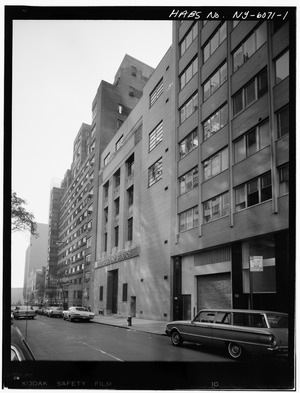Beaux-Arts Institute of Design facts for kids
The Beaux-Arts Institute of Design (BAID) was a special school in New York City. It taught students how to become architects (people who design buildings), sculptors (artists who make statues), and mural painters (artists who paint on walls). The school was located at 304 East 44th Street in the Turtle Bay, Manhattan area.
It was started in 1916 by Lloyd Warren. His goal was to train American artists and designers using ideas from a famous French art school called the École des Beaux-Arts. Today, the building where BAID once stood is used by Egypt's mission to the United Nations.
Contents
How the School Started
The Beaux-Arts Institute of Design grew from a group called the Society of Beaux-Arts Architects. This group was made up of American architects who had studied at the famous school in Paris, France.
Since 1894, the Society of Beaux-Arts Architects wanted to make architectural education better in the United States. They created standard design problems for students to work on. These problems were used in architecture schools and independent art studios across the country. This helped to improve and standardize how architecture was taught.
By 1916, so many schools and studios were taking part that the Society couldn't handle all the work. So, they created BAID to continue this important job. For sculptors, BAID helped make sure there were enough skilled artists for decorative work. This also allowed members of the National Sculpture Society to focus on being fine artists.
School History
The National Sculpture Society gave a building at 126 East 75th Street to the new BAID school. Classes began on September 18, 1916. There were three main departments:
- Architecture, linked to the Society of Beaux-Arts Architects.
- Sculpture, linked to the National Sculpture Society.
- Mural painting, linked to the Society of Mural Painters.
Architect Frederic Charles Hirons was very important to BAID. He helped start the school in 1916. He also designed the BAID building in 1928 after winning a design contest. Hirons was also the president of the Society of Beaux-Arts Architects from 1937 to 1939.
Another founder was Lloyd Warren. He was key in getting top artists and architects to teach at BAID. They also helped judge student competitions, which was great for the art and design fields.
In 1927, Carl Conrad Franz Kressbach won the first annual Whitney Warren architectural competition. He was a student at Harvard University. His design for "An airport for a large city" showed how commercial planes could be sent and received. This design got a lot of attention from people interested in the future of air travel.
In 1956, the school changed its name to the National Institute for Architectural Education. This showed that it was moving away from focusing only on European traditions. In 1995, it changed its name again to the Van Alen Institute.
What Students Did at BAID
BAID held architectural competitions that were known all over the country. University architecture schools and independent studios would send their students' work to New York City for judging. In the 1929–1930 school year, BAID received the most entries ever, with 9,500 designs to judge!
BAID also offered classes and studios on-site. The sculpture studios were open for many hours, even into the evenings. This was helpful for students who worked during the day and for teachers who taught part-time.
Many students at BAID were immigrants or the first in their families to be born in America. They often came from working-class families. Their training at BAID helped them get jobs in the building trades, like construction. Many of these students also attended the Art Students League of New York.
Famous People Who Studied Here
Many talented artists and architects studied at the Beaux-Arts Institute of Design. Here are some of them:
- Edmond Romulus Amateis, a sculptor.
- Beniamino Benvenuto Bufano, a sculptor.
- Gaetano Cecere, a sculptor.
- Rose Connor, an architect.
- Herbert Ferber, a sculptor.
- Mitchell Fields, a sculptor.
- Harold H. Fisher, a church architect.
- Paul Fjelde, a sculptor and professor.
- Vincent Glinsky, a sculptor and instructor.
- Chaim Gross, a sculptor.
- Stratton Hammon, an architect known for Colonial Revival homes.
- Milton Hebald, a sculptor.
- Henry Hensche, a painter.
- Oswald Hoepfner, a student and instructor.
- Herbert B. Hunter, an architect.
- Joseph Kiselewski, a sculptor.
- Ibram Lassaw, a sculptor.
- Ellamae Ellis League, an architect and the first woman from Georgia to be a Fellow of the American Institute of Architects (FAIA).
- John Gaw Meem, an architect.
- Arthur C. Morgan, a sculptor.
- Jules Olitski, a painter.
- Corrado Parducci, a sculptor.
- David K. Rubins, a sculptor.
- Louis Slobodkin, a sculptor and children's book author.
- Cesare Stea, a sculptor.
- Albert Stewart, a sculptor.
- Robert Edward Weaver, a muralist, painter, and sculptor.
- Albert W. Wein, a sculptor.
- Paul R. Williams, an architect.
See Also


